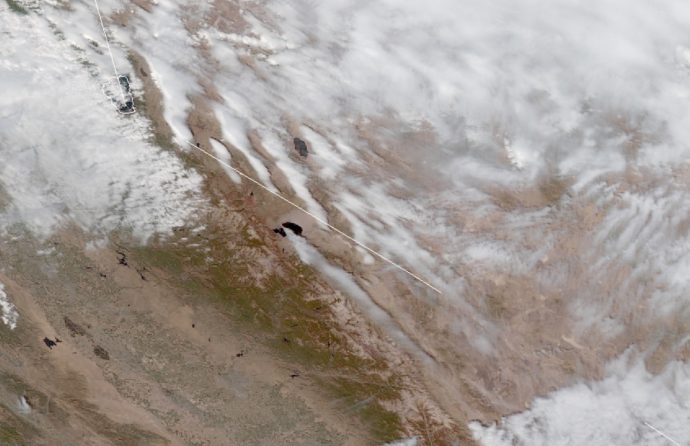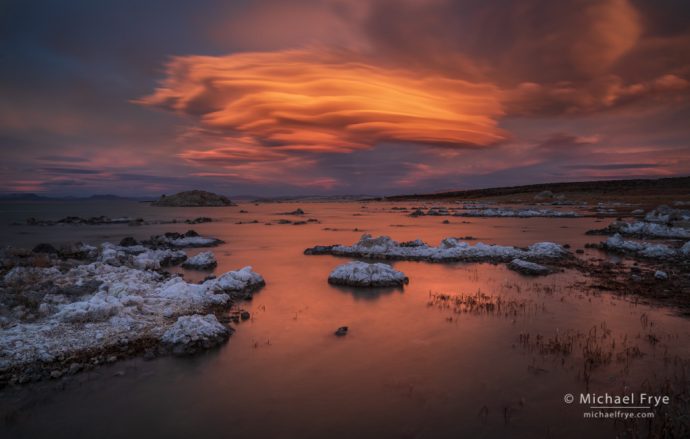We just finished our workshop in the eastern Sierra, and had a great time. We had to look a little harder for colorful aspens this year, but in the end we found plenty.
The workshop ended on Friday. Yesterday Claudia and I slept in a bit, then did an interview, packed up our classroom space from the workshop, and had an early dinner at the Whoa Nellie Deli in Lee Vining.
By then it was about 4:45 p.m, with sunset at about 6:15. It was windy, with mostly-cloudy skies. Satellite images showed lots of high clouds to the west, and it seemed likely that those high clouds would block the sun and hinder the chances for an interesting sunset. But those high clouds were moving very quickly, so it seemed possible that they might clear out by sunset. And out over Mono Lake I could see lots of beautiful, saucer-shaped, lenticular clouds, which would look spectacular if the sun did break through. It seemed worth waiting an hour or so to find out.
Lenticular clouds are generated by strong winds passing over mountains. The air rushes downward rapidly on the leeward side of the mountains (usually the east side), then bounces up, then down, then up, and so on, in a wave pattern. On the upward bounces the air gets cooled and generates clouds. That’s what happened yesterday. There were no lenticular clouds over the Sierra crest, but on the satellite images I could see standing waves of clouds to the east of the mountains:

Satellite image from 2:21 p.m. yesterday. Mono Lake is just left of center, Walker Lake just above Mono Lake, and Lake Tahoe in the upper-left corner. You can see a long wave cloud starting at Mono Lake and extending southeast, along with repeating, standing waves between Lake Tahoe and Walker Lake.
I waited at a favorite spot along the western shore of Mono Lake. But as six o’clock approached I could see sunlight off to the left (north), and a particularly beautiful cloud in that direction that looked like it could get some light. I needed a better view to the north, so I moved down to the lakeshore and rushed out to find a spot.
By then the cloud that had looked so interesting a few minutes earlier didn’t look quite so compelling. But a different cloud off to the east, with beautiful, sculpted layers, started to light up. So I scrambled to find a good foreground for that direction, splashing through shallow, muddy, salty water along the shore, eventually finding a spot with a nice arrangement of low, white, salt-encrusted tufa formations.
The wind made the water choppy, so I put on a 7-stop neutral-density filter to slow down the shutter speed and smooth out the water. I was worried about the wind shaking the tripod and blurring the photos, but I magnified the images and they looked sharp. The cloud grew more and more colorful, turning from orange to red and pink, but I liked this earlier image best, when the cloud had more distinct layers.
I’ll post more photos from the eastern Sierra when I get a chance to process them, but I thought I’d start with this – one of the most striking cloud formations I’ve ever seen.
— Michael Frye
Related Posts: Storm Clouds Over Mono Lake; Moods of Mono Lake
Michael Frye is a professional photographer specializing in landscapes and nature. He is the author or principal photographer of The Photographer’s Guide to Yosemite, Yosemite Meditations, Yosemite Meditations for Women, Yosemite Meditations for Adventurers, and Digital Landscape Photography: In the Footsteps of Ansel Adams and the Great Masters. He has also written three eBooks: Light & Land: Landscapes in the Digital Darkroom, Exposure for Outdoor Photography, and Landscapes in Lightroom: The Essential Step-by-Step Guide. Michael has written numerous magazine articles on the art and technique of photography, and his images have been published in over thirty countries around the world. Michael has lived either in or near Yosemite National Park since 1983, currently residing just outside the park in Mariposa, California.










I was in Yosemite and Eastern Sierra last week as well, shooting large format film with Jon Paul, and we did find some wonderful fall scenes in Lundy Canyon and Yosemite. Looking forward to seeing your fall color images. The sunrise over Mono Lake was beautiful on Friday AM, but unfortunately had to fly home to NC in the afternoon. Wish I could have witnessed that spectacular lenticular cloud.
Glad you found autumn Martin, though sorry you missed that cloud.
What an exceptional photo — all the more impressive when knowing the circumstances in which it was made.
I had a basketball coach who used to say “luck is when preparation meets opportunity.”
I think he would have said, about this photo, “luck is when truly exceptional preparation — knowledge, skill, experience — meets a magical moment.”
Thanks very much Dave!
That’s a very beautiful sky, Michael. Wish I could find them when I’m there. 🙂
Do you use a particular app to find your satellite images?
Thanks John! I mostly use the satellite images on the NWS website.
Than you Michael.
A phenomenal Image!
Thanks Wes!
I think I’ll be voting that one in your yearly favorites poll :-). Beautiful.
Hi Michael! Thanks for capturing another winning, spectacular photo along with the informative timelines that were used to get you to that magical moment. Even though I enjoy living on the beautiful western slope of the Sierra, I absolutely love the eastern slope thanks to all the backpacking I did there years ago.
I couldn’t help but think of you and the coincidental timing of the PBS new showing of “Outside Beyond the Lens:”, highlighting the fall colors of the eastern side of the Sierra. It’s worth watching the 30 min. presentation. –> https://www.pbs.org/video/outside-beyond-the-lens-east-side-colors-4kbneu/